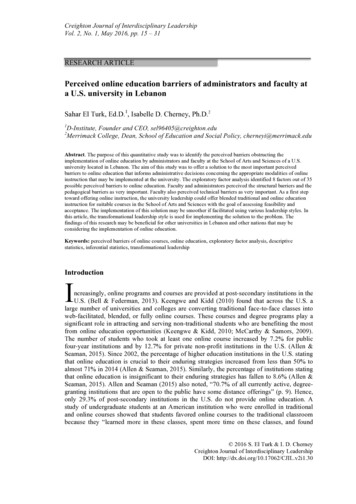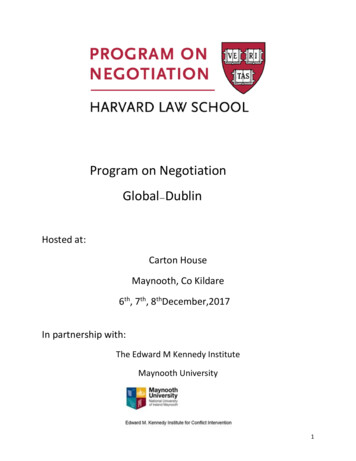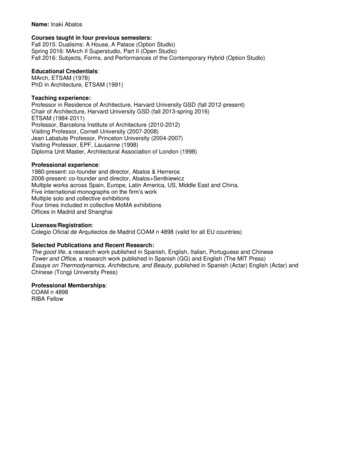
Transcription
Chapter 1CombinatoricsCopyright 2009 by David Morin, morin@physics.harvard.edu (Version 4, August 30, 2009)This file contains the first three chapters (plus some appendices) of a potential book on Probabilityand Statistics. It does not assume knowledge of calculus. The first three chapters are titled “Combinatorics,” “Probability,” and “Distributions.” And Appendix B gives a nice little introduction tothe natural logarithm, e. Future chapters on statistics will be added in the summer of 2010.Combinatorics is the study of how to count things. By “things” we mean the variouscombinations, permutations, subgroups, etc., that can be formed from a given set of objectsor events. For example, how many different committees of three people can be chosen fromfive people? How many different full-house hands are there in poker? How many differentoutcomes are possible if you flip a coin four times? Knowing how to count such things iscritical for an understanding of probability, because when calculating the probability of agiven event, we invariably need to count the number of ways that this event can happen.The outline of this chapter is as follows. In Section 1.1 we introduce the concept offactorials, which will be ubiquitous in our study of probability. In Section 1.2 we learn howto count the number of possible permutations (that is, the number of possible orderings)of a set of objects. In Section 1.3 we learn how to count the number of possible subgroupsthat can be formed from a set of objects. We consider both the case where the order ofthe objects matters, and the case where it doesn’t matter. For example, the poker questionposed above is one where the order of the objects (the cards) doesn’t matter. In Section 1.4we learn how to count the number of possible outcomes of a repeated experiment, whereeach repetition has an identical set of possible results. Examples include rolling dice orflipping coins. Finally, in Section 1.5 we look at the coin-flipping example in more detail,and we see how it relates to a set of numbers called the binomial coefficients.Having learned how to count all these things, we’ll then see in Chapter 2 how the resultscan be used to calculate probabilities. It turns out that it’s generally a trivial step to obtaina probability once you’ve counted the relevant things, so the bulk of the work we’ll need todo will be in the present chapter.1.1FactorialsBefore getting into the discussion of actual combinatorics, we’ll first need to look at a certainquantity that comes up again and again. This quantity is called the factorial. We’ll seethroughout this chapter that when dealing with a situation that involves an integer N ,we often need to consider the product of the first N integers. This product is called “N1
2CHAPTER 1. COMBINATORICSfactorial,” and it is denoted by the shorthand notation, “N!”.1 For the first few integers, wehave:1!2!3!4!5!6! 11·2 21·2·3 61 · 2 · 3 · 4 241 · 2 · 3 · 4 · 5 1201 · 2 · 3 · 4 · 5 · 6 720(1.1)As N increases, N ! gets very big very fast. For example, 10! 3, 628, 800, and 20! 2.43 · 1018 . In Chapter 3 we’ll make good use of an approximate formula for N !, calledStirling’s formula. This formula will make it clear what we mean by the statement, “N !gets very big very fast.”We should add that 0! is defined to be 1. Of course, 0! doesn’t make much sense, becausewhen we talk about the product of the first N integers, it is understood that we start with1. Since 0 is below this starting point, it is unclear what 0! actually means. However, there’sno need to think too hard about trying to make sense out of it, because as we’ll see below,if we simply define 0! to be 1, then a number of formulas turn out to be very nice.Having defined N !, we can now start counting things. There are two main things we’llneed to know how to count, and the results for both of these involve N !. These two things are(1) the permutations (the orderings) of N objects , and (2) the number of ways of choosingsubgroups from N objects, for example, the number of different committees of three peoplethat can be chosen from five people. Let’s look at each of these in turn.1.2PermutationsA permutation of a set of objects is a way of ordering them. For example, if we have threepeople, Alice, Bob, and Carol, then one permutation of them is Alice, Bob, Carol. Anotherpermutation is Carol, Alice, Bob. And another is Bob, Alice, Carol. The goal of this sectionis to learn how to count the number of possible permutations. We’ll do this by starting offwith the very simple case where we have just one object. Then we’ll consider two objects,then three, and so on, until we see a pattern. As we’ll find throughout this book, this isinvariably a good strategy when trying to figure something out: Start with small numbers,and then gradually increase until you see a pattern.One objectIf we have only one object, then there is clearly only one way to “order” it. There is noordering to be done. A list of one object simply consists of that one object, and that’s that.If we use the notation where PN stands for the number of permutations of N objects, thenwe have P1 1.Two objectsWith two objects, things aren’t completely trivial like they were in the one-object case, butthey’re still very simple. If we label our two objects as “1” and “2,” then we can order themin two ways:1 I’m not sure why someone long ago picked the exclamation point for this notation. But just rememberthat it has nothing to do with the more common grammatical use of the exclamation point for emphasis.So try not to get too excited when you see “N!”!
1.2. PERMUTATIONS12or321So we have P2 2. At this point, you might be thinking that this result, along with theprevious P1 1 result, implies that PN N for any number N . This would imply thatthere should be three different ways to order three objects. Well, not so fast. . .Three objectsThings get more interesting with three objects. If we call them “1,” “2,” and “3,” then wecan list out the possible orderings. (If you haven’t already looked at the table below, youshould cover it up with your hand and try to list out all the permutations yourself. We’lleven add on this extra sentence here to make this parenthetical remark a little longer, sothat you don’t have any excuse for saying that you already looked at it!) The permutationsare:123132213231312321Table 1.1So we have P3 6. Note that we’ve grouped these six permutations into three subgroups(the three columns), according to which number comes first. It isn’t necessary to groupthem this way, but we’ll see below that this method of organization has definite advantages.It will simplify how we think about the case where the number of objects is a general numberN.Remark: There’s no need to use the numbers 1,2,3 to represent the three objects. You can usewhatever symbols you want. For example, the letters A,B,C work fine, as do the letters H,Q,Z.You can even use symbols like , , . Or you can mix things up with ,W,7 if you want tobe unconventional. The point is that the numbers/letters/symbols/whatever simply stand forthree different things, and they need not have any meaningful properties except for their differentappearances when you write them down on the paper.However, there is certainly something simple about the numbers 1,2,3,. . ., or the letters A,B,C,. . .,so we’ll generally work with these. In any event, it’s invariably a good idea to be as economical aspossible and not write down the full names, such as Alice, Bob, and Carol. Of course, with thesethree particular names, there’s some logic in going with A,B,C. Four objectsThe pattern so far is P1 1, P2 2, and P3 6. Although you might be able to guess thegeneral rule from these three results, it will be easier to see the pattern if we look at thenext case with four objects. Taking a cue from the above list of six permutations of threeobjects, let’s organize the permutations of four object according to which number starts thelist. (Again, you should cover up the following table with your hand and try to list out allthe permutations yourself.) We end up with:123412431324134214231432Table 1412341324213423143124321
4CHAPTER 1. COMBINATORICSIf we look at the last column, where all the permutations start with “4,” we see that if westrip off the “4,” we’re simply left with the six permutations of the three numbers 1,2,3that we listed above. A similar thing happens with the column of permutations that startwith “3.” If we strip off the “3,” we’re left with the six permutations of the numbers 1,2,4.Likewise for the columns of permutations that start with “2” or “1.” The 24 permutationslisted above can therefore be thought of as four groups (the four columns), each consistingof six permutations.Five objectsFor five objects, you probably don’t want to write down all the permutations, because itturns out that there are 120 of them. But you can imagine writing them all down. And forthe present purposes, that’s just as good as (or perhaps even better than) actually writingthem down for real.Consider the permutations of 1,2,3,4,5 that start with “1.” From the above result forthe N 4 case, the next four numbers 2,3,4,5 can be permuted in 24 ways. So thereare 24 permutations that start with “1.” Likewise, there are 24 permutations that startwith “2.” And similarly for 3, 4, and 5. So we have five groups (columns, if you want toimagine writing them that way), each consisting of 24 permutations. The total number ofpermutations of five objects is therefore 5 · 24 120.General case of N objectsPutting all the above results together, we haveP1 1,P2 2,P3 6,P4 24,P5 120.(1.2)Do these numbers look familiar? Yes indeed, they are simply the N ! results from Eq. (1.1)!Does this equivalence make sense? Yes, due to the following reasoning. P1 1, of course. P2 2, which can be written in the suggestive form, P2 2 · 1. For P3 , Table 1.1 shows that P3 6 can be thought of as three groups (characterizedby which number appears first) of the P2 2 permutations of the second and thirdnumbers. So we have P3 3P2 3 · 2 · 1. Similarly, for P4 , Table 1.2 shows that P4 24 can be thought of as four groups(characterized by which number appears first) of the P3 6 permutations of thesecond, third, and fourth numbers. So we have P4 4P3 4 · 3 · 2 · 1. And likewise, the above reasoning for N 5 shows that P5 5P4 5 · 4 · 3 · 2 · 1. Andso on and so forth. Therefore: At each stage, we have PN N · PN 1 . This relation is easily seen to be satisfied bythe general formula,PN N !.(1.3)Basically, you just need to tack on a factor of N at each stage, due to the fact thatthe permutations can start with any of the N numbers (or whatever objects you’redealing with). The number of permutations of N objects is therefore N !.
1.3. CHOOSING SUBGROUPS5The strategy of assigning seatsAn equivalent way of thinking about this result is the following. For concreteness, let’s saythat we have four people, Alice, Bob, Carol, and Dave. And let’s assume that they need tobe assigned to four seats arranged in a line. The above PN N ! results tells us that thereare 4! 24 different permutations (orderings) they can take. We’ll now give an alternatederivation that shows how these 24 orderings can easily be understood by imagining theseats being filled one at a time. We’ll get a lot of mileage out of this type of “seat filling”argument throughout this (and also the next) chapter. There are four possibilities for who is assigned to the first seat. For each of these four possibilities, there are three possibilities for who is assigned tothe second seat (because we’ve already assigned one person, so there are only threepeople left). So there are 4 · 3 12 possibilities for how the inhabitants of the firsttwo seats are chosen. For each of these 12 possibilities, there are two possibilities for who is assigned tothe third seat (because there are only two people left). So there are 4 · 3 · 2 24possibilities for how the inhabitants of the first three seats are chosen. Finally, for each of these 24 possibilities, there is only one possibility for who is assignedto the fourth seat (because there is only one person left, so we’re stuck with him/her).So there are 4 · 3 · 2 · 1 24 possibilities for how the inhabitants of all four seats arechosen. The “1” here doesn’t matter, of course; it just makes the formula look nicer.You can see how this counting works for the N 4 case in Table 1.2. There are fourpossibilities for the first entry, which stands for the person assigned to the first seat if welabel the people by 1,2,3,4. Once we pick the first entry, there are three possibilities for thesecond entry. And once we pick the second entry, there are two possibilities for the thirdentry. And finally, once we pick the third entry, there is only one possibility for the fourthentry. You can verify all these statements by looking at the table.It should be emphasized that when dealing with situations that involve statements suchas, “There are a possibilities for Event 1, and for each of these there are b possibilities forEvent 2, and for each of these there are c possibilities for Event 3, and so on. . . ,” the totalnumber of different scenarios when all the events are listed together is the product (not thesum!) of the different numbers of possibilities, that is, a · b · c · · ·. You should stare at Table1.2 until you’re comfortable with this.1.31.3.1Choosing subgroupsChoosing pairsIn addition to permutations, the other main thing we’ll need to know how to count is thenumber of different subgroups of a given size, chosen from a given set of objects. Forexample, let’s say we have five people in a room and we need to pick two of them to be ona committee. How many different pairs can we pick? (Note that the order within the pairdoesn’t matter.) We’ll present three ways of answering this question.First method: If we label the five people as A,B,C,D,E, we can simply list out all thepossible pairs. And we can group them in the following suggestive way (remember that theorder doesn’t matter, so once we’ve listed, say, AB, we don’t need to list BA):
6CHAPTER 1. COMBINATORICSABACADAEBCBDBECDCEDETable 1.3So there are 10 possible pairs. This table also quickly tells us how many pairs there are ifwe have four people in all, instead of five. We simply have to remove the bottom row, sincethe fifth person (E) doesn’t exist. We therefore have six pairs. Similarly, if we also removethe “D” row, we see that three people yield three pairs. And then two people of course yieldjust one pair.We can also go in the other direction and increase the number of people. With six peoplein the room, we simply need to add an “F” row to the table, consisting of AF, BF, CF, DF,¡ EF. This adds on another five pairs, so six people yield 15 pairs. In general, if we let N2denote the number of possible pairs (that’s the “2”) that can be chosen from N people,2then by considering the above table to be the collection of rows with increasing length (1,then 2, then 3, then 4, etc.), we findµ ¶2 1,2µ ¶3 1 2 3,2µ ¶4 1 2 3 6,2µ ¶5 1 2 3 4 10,2µ ¶6 1 2 3 4 5 15,2µ ¶7 1 2 3 4 5 6 21.(1.4)2The number of possible pairs among N people is therefore the sum of the first N 1 integers.It would be nice if there were a general formula for this sum, so wehave to actually¡ wouldn’t add up all the numbers. It would be a huge pain to determine 100thisway.And indeed,2there is a general formula, and it happens to beµ ¶NN (N 1) 22You can verify that this is consistent with the above list of¡7 2 7 · 6/2 21.(1.5)¡N 2values. For example,Remark: If you’re wondering how to prove that the sum of the first N 1 integers equalsN (N 1)/2, we’ll end up effectively deriving this in the second and third methods below. Butfor now we’ll just relate a story about the mathematician Carl Friedrich Gauss. One day in gradeschool (or so the story goes), his teacher tried to quiet the students by giving them the task ofadding up the numbers 1 through 100. But to the teacher’s amazement, after a few seconds Gauss2 This¡N is called a binomial coefficient. It is read as “N choose 2.” We’ll talk about binomial2coefficients in detail in Section 1.5.
1.3. CHOOSING SUBGROUPS7came up with the correct answer, 5050. How did he arrive at this so quickly? Well, he wrote outthe numbers in increasing order, and then below these he listed them out in decreasing order:1100299398······9839921001He then noted that every column of two numbers has the same sum, 101. And since there are 100columns, the total sum is 10100. But he counted every number twice, so the sum of the numbers1 through 100 is half of 10100, or 5050. As we saw with the triangle in Table 1.3, and as we’ll seemany more times, things become much clearer if you group objects in certain ways! Second method: Given the letters A,B,C,D,E, let’s write down all the possible pairs ofletters, including repetitions, and also different orderings. There are five possibilities for thefirst entry, and also five possibilities for the second entry, so we end up with a 5 by 5 squareof possible ECEDEETable 1.4However, the pairs with repeated letters (shown in italics) don’t count, because the twopeople on the committee must of course be different people (no cloning allowed!). Furthermore, we aren’t concerned with the ordering of the people within the pair, so AB and BArepresent the same committee. Likewise for AC and CA, etc. The upper right triangle inthe square therefore simply duplicates¡ the lower left triangle, which itself is just the trianglein Table 1.3. So we end up with 52 10 again.The advantage of writing down the whole square in Table 1.4 is that the resulting answerof 10 can be thought of as taking 25 (which is 5 squared) and subtracting off 5 (to eliminatethe pairs with repeated letters), and then taking half of the result (due to the duplicate¡ triangles). This way of thinking allows us to quickly write down the general result for N2 .In forming pairs from N people, we can imagine writing down an N by N square whichyields N 2 pairs; and then subtracting off the N pairs with repeated letters, which leaves uswith N 2 N pairs; and then taking half of the result due to the duplicate triangles (forevery pair XY there is also an equivalent pair YX). So we haveµ ¶N1N (N 1) (N 2 N ) ,(1.6)222in agreement with Eq. (1.5).Third method: This third method is superior to the previous two, partly because it isquicker, and partly because it can easily be generalized to subgroups involving more thantwo members (see Section 1.3.2 below). Our strategy will be to pick the two committeemembers one at a time, just as we did at the end of Section 1.2 when we assigned people toseats.Starting again with the case of five people, we can imagine having two seats that needto be filled with the two committee members. There are 5 options for who goes in the firstseat. And then for each of these possibilities there are 4 options for who goes in the secondseat, since there are only 4 people left. So there are 5 · 4 20 ways to plop the two peopledown in the two seats. (This is exactly the same reasoning as with the N ! ways to assign
8CHAPTER 1. COMBINATORICSpeople to N seats, but we’re simply stopping the assignment process after two seats. So wehave only the product 5 · 4 instead of the product 5 · 4 · 3 · 2 · 1.) However, we double countedevery pair in this reasoning. The pair XY was counted as distinct from the pair YX. So weneed to divide by 2. The number of pairs we can pick from 5 people is therefore 5 · 4/2 10,as we found above.The preceding reasoning easily generalizes to the case where we pick pairs from N people.We have N options for who goes in the first seat, and then for each of these possibilities thereare N 1 options for who goes in the second seat. This gives N (N 1) total possibilities.But since we don’t care about the order, this reasoning double counted every pair. Wetherefore need to divide by 2, yielding the final result ofµ ¶NN (N 1),(1.7) 22in agreement with the above two methods.1.3.2Generalizing to other subgroupsDetermining¡ 5 3What if we want to pick a committee consisting of three people? Or four? Or a generalnumber n? (n can’t be larger than the total number of people, N , of course.) For smallnumbers N and n, we can simply list out the possibilities. For example, if we have fivepeople and we want¡ to pick a committee of three (so in our above “choose” notation, wewant to determine 53 ), we find that there are 10 possibilities:ABCABDABEACDACEADEBCDBCEBDECDETable 1.5We’ve grouped these according to which letter comes first. (The order of letters doesn’tmatter, so we’ve written each triplet in increasing alphabetical order.) If you want, youcancolumnsand think of 10 as equaling 6 3 1, or more informatively as¡4 look¡3 at¡2these ¡ 4 .Theherecomes from the fact that once we’ve chosen the first letter to be222¡ 2A, there are 42 6 ways to pick the other two letters from B,C,D,E. This yields the first¡ column in the table. Likewise for the second column with 32 3 triplets (with two letters¡ 2 chosen from C,D,E), and the third column with 2 1 triplet (with two letters chosen¡ ¡ ¡ ¡ from D,E). See Problem 4 for the generalization of the fact that 53 42 32 22 .You can also think of these 10 triplets as forming a pyramid. There are six triplets (theones that start with A) in the bottom plane, three triplets (the ones that start with B)in the middle plane, and one triplet (the one that starts with C) in the top plane. Thispyramid for the triplets is the analogy of the triangle for the pairs in Table 1.3. However,the pyramid (and the exact placement of all the triplets within it) is certainly harder tovisualize than the triangle, so it turns out not to be of much use. The point of listing outthe possibilities in a convenient geometrical shape is so that it can help you do the counting.If the geometrical shape is a pain to visualize, you might as well not bother with it.It’s possible to explicitly list out the various possibilities (in either columns or pyramids)for a small number like 5. But this practice becomes intractable when the number of people,
1.3. CHOOSING SUBGROUPS9N , is large. Furthermore, if you want to think in terms of pyramids, and if you’re dealingwith committees consisting of four people, then you’ll have to think about “pyramids” infour dimensions. Not easy! Fortunately, though, the third method in Section 1.3.1 easilygeneralizes to triplets and larger subgroups. The reasoning is as follows.Calculating¡N 3Consider the case of triplets. Our goal is to determine the number of committees of¡ three people that can be chosen from N people. In other words, our goal is to determine N3 .We can imagine having three seats that need to be filled with the three committeemembers. There are N options for who goes in the first seat. And then for each of thesepossibilities there are N 1 options for who goes in the second seat (since there are onlyN 1 people left). And then for each of these possibilities there are N 2 options for whogoes in the third seat (since there are only N 2 people left). This gives N (N 1)(N 2)possibilities. However, we counted every triplet six times in this reasoning. All six triplets ofthe form XYZ, XZY, YXZ, YZX, ZXY, ZYX were counted as distinct triplets. Since they allrepresent the same committee (because we don’t care about the order), we must thereforedivide by 6. Note that this “6” is nothing other than 3!, because it is simply the number ofpermutations of three objects. Since we counted each permutation as distinct in the abovecounting procedure, the division by 3! corrects for this. (Likewise, the 2 that appeared inthe denominator of N (N 1)/2 in Section 1.3.1 was technically 2!.) We therefore arrive atthe result,µ ¶NN (N 1)(N 2) .(1.8)33!¡ Plugging in N 5 gives 53 10, as it should.For future reference, note that we can write Eq. (1.8) in a more compact way. If wemultiply both the numerator and denominator by (N 3)!, the numerator becomes N !, sowe end up with the nice concise expression,µ ¶NN! .(1.9)33!(N 3)!Calculating¡N nThe above reasoning with triplets quickly generalizes to committees with larger numbers ofpeople. If we have N people and we want to pick a committee of n, then we can imagineassigning people to n seats. There are N options for who goes in the first seat. And thenfor each of these possibilities there are N 1 options for who goes in the second seat (sincethere are only N 1 people left). And then for each of these possibilities there are N 2options for who goes in the third seat (since there are only N 2 people left). And soon, until there are N (n 1) options for who goes in the nth seat (since there are onlyN (n 1) people left, because n 1 people have already been chosen). The number ofpossibilities for what the inhabitants of the n seats look like is therefore¡ ¡ N (N 1)(N 2) · · · N (n 2) N (n 1) .(1.10)However, we counted every n-tuplet n! times in this reasoning, due to the fact that thereare n! ways to order any group of n people, and we counted all of these permutations asdistinct. Since we don’t care about the order, we must divide by n! to correct for this. Sowe arrive at¡ ¡ µ ¶N (N 1)(N 2) · · · N (n 2) N (n 1)N.(1.11) n!n
10CHAPTER 1. COMBINATORICSAs in the n 3 case, if we multiply both the numerator and denominator by (N n)!, thenumerator becomes N !, and we end up with the concise expression,µ ¶N!N nn!(N n)!(1.12)For example, the number of ways to pick a committee of four people from six people isµ ¶66! 15.(1.13)44!2!You should check this result by explicitly listing out the 15 groups of four people.Note that because of our definition¡ of 0! 1 in Section 1.1, Eq. (1.12) is valid even inthe case of n N , because we have NN N !/N !0! 1. And indeed, there is just one wayto pick N people from ¡N people. You simply pick all of them. Another special case is then 0 one. This gives N0 N !/0!N ! 1. It’s sort of semantics to say that there is oneway to pick zero people from N people (you simply don’t pick any, and that’s the one¡ way).But we’ll see later on, especially when dealing with the binomial theorem, that N0 1makes perfect sense.¡ Example (Equal coefficients): We just found that 64 6!/4!2! 15. But note that¡6 ¡ ¡ 6!/2!4! also equals 15. Both 64 and 62 involve the product of 2! and 4! in the2denominator, and since ¡the order¡ doesn’t matter in this product, the result is the same. Wealso have, for example, 11 11. Both of these equal 165. Basically, any two n’s that add38¡ Nup to N yield the same value of n .(a) Demonstrate this mathematically.(b) Explain in words why it is true.Solution:(a) Let the two n values be labeled as n1 and n2 . If they add up to N , then they musttake the forms of n1 a and n2 N a for some value of a. (The above example¡ withN 11 was generated by either a 3 or a 8.) Our goal is to show that nN1 equals¡N . And indeed,n2µ ¶Nn1 N!N! ,n1 !(N n1 )!a!(N a)!Nn2 N!N!N!¡ .n2 !(N n2 )!(N a)!a!(N a)! N (N a) !µ ¶(1.14)The order of the a! and (N a)! in the denominators doesn’t matter, so the two resultsare the same, as desired.3(b) Imagine picking n objects¡ from N objects and then putting them in a box. The numberof ways to do this is N, by definition. But note that you generated two sets of objectsnin this process: there are the n objects in the box, and there are also the N n objectsoutside the box. There’s nothing special about being inside the box versus being outside,so you can equivalently consider your process to be a way of picking the group of N nobjects that remain outside the box. Said in another way, a perfectly reasonable way3 Inpractice, when calculating¡N n, you want to cancel the larger of the factorials in the denominator. Forexample, you would quickly cancel the 8! in both¡11 3and¡11 8and write them as (11 · 10 · 9)/(3 · 2 · 1) 165.
1.3. CHOOSING SUBGROUPS11of picking a committee of n members is to pick the N n members who are not on thecommittee. There is therefore a direct correspondence between each set of n objectsand the complementary (remaining) set of N n objects. The number of different setsof n objects is therefore equal to the number of different sets of N n objects, as wewanted to show.1.3.3Situations where the order mattersUp to this point, we have considered committees/subgroups in which the order doesn’tmatter. But what if the order does matter? For example, what if we want to pick acommittee of three people from N people, and furthermore we want to designate one ofthe members as the president, another as the vice president, and the third as just a regularmember? The positions are now all distinct.As we have done previously, we can imagine assigning the people to three seats. Butnow the seats have the names of the various positions written on them, so the order matters.From the reasoning preceding Eq. (1.8), there are N (N 1)(N 2) ways of assigning peopleto the three seats. And that’s the answer for the number of possible committees in which theorder matters. We’re done. We don’t need to divide by 3! to correct for multiple countinghere, because we haven’t done any multiple counting. The triplet XYZ is distinct from,say, XZY because although both committees have X as the president (assuming we labelthe first seat as the president), the first committee has Y as the vice president, whereas thesecond committee has Z as the vice president. They are different committees.The above reasoning quickly generalizes to the case where we want to pick a committeeof n people from N p
by which number appears flrst) of the P2 2 permutations of the second and third numbers. So we have P3 3P2 3 2 1. † Similarly, for P4, Table 1.2 shows that P4 24 can be thought of as four groups (characterized by which number










